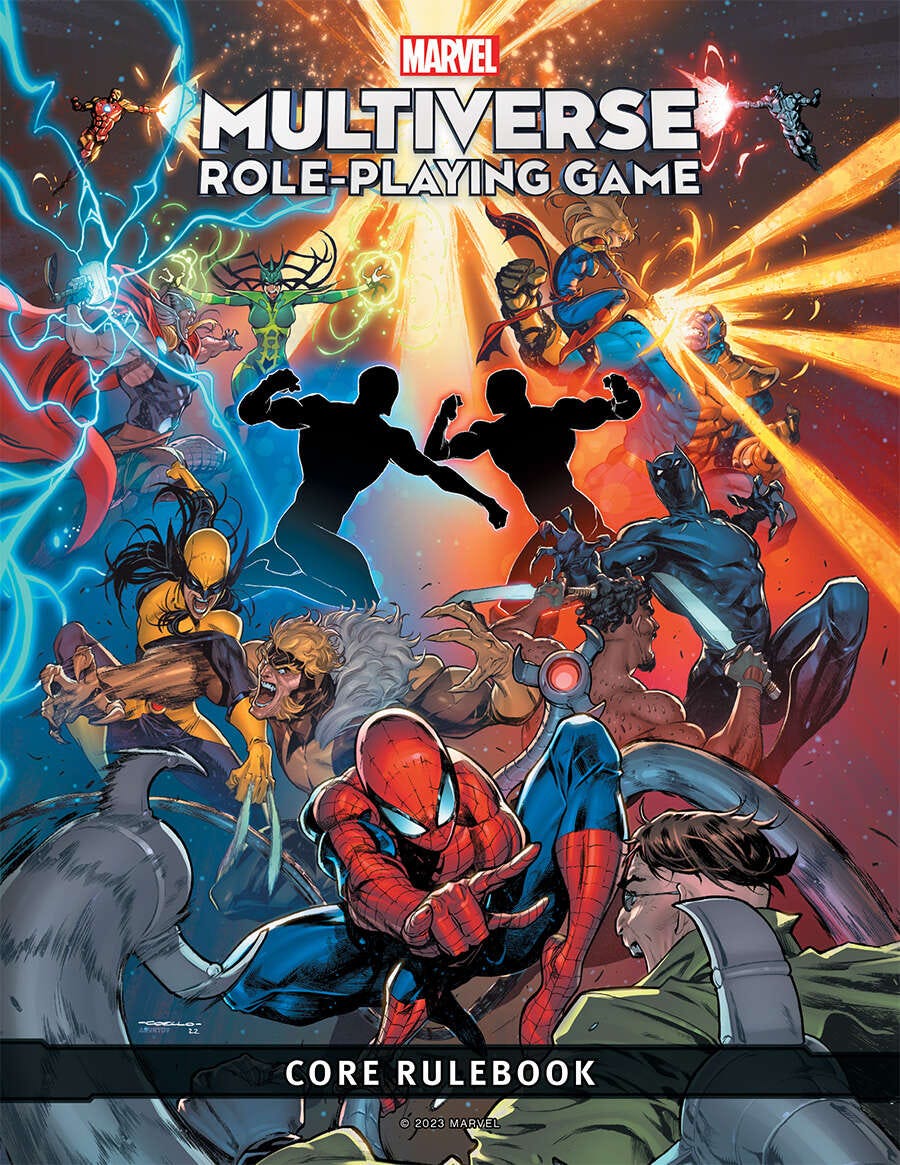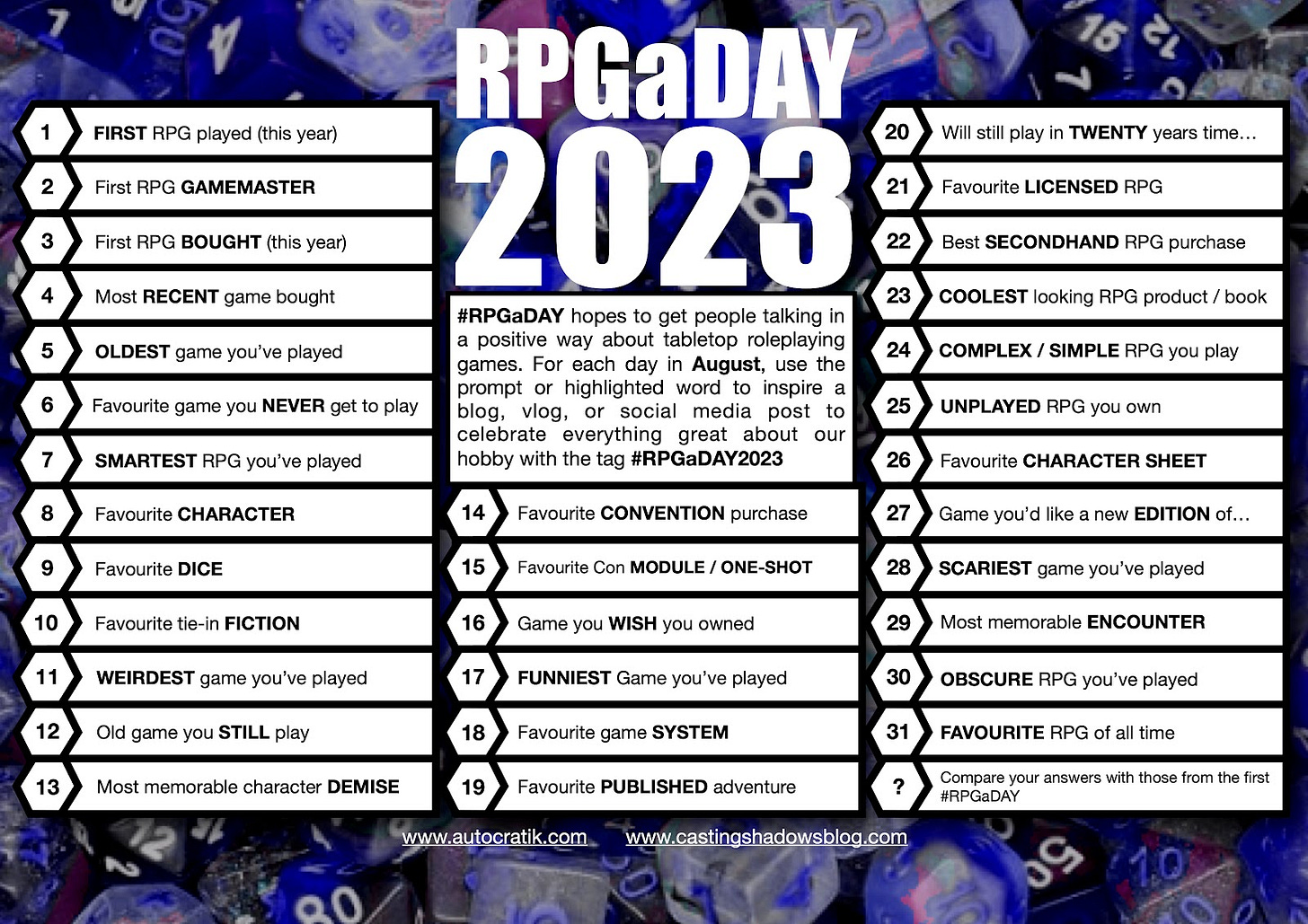Finishing Independent RPG Month
It's Clobberin' Time!
At last we come to August and I can finalize my list of recommended independent games. So far, I’ve recommended 28 games that represented a wide swath of the hobby with regards to genre and mechanics.
Last week’s entry focused entirely on horror rpgs other than Call of Cthulhu. As good as that game is, it looms overly large over the horror side of role playing and I wanted to offer a couple of alternatives that I believe are worth your time. It is a deep genre with a rich catalog of offerings that cover a wide range of styles, as befits a literary genre that does the same. The horror genre in rpgs is so deep with worthy offerings that I didn’t even have time to recommend Dread or Ten Candles. Both of those games have strong fan communities. I’ve played Dread, and enjoyed it, but don’t have an opinion on Ten Candles.
This week’s final three entries return to the past trend of recommending games from several genre. I also opted to go with games with very different mechanics too. As you might have guessed from prior weeks, I am including a Super Hero role playing game this week. In fact, waiting for my copy of this game to arrive so that I could read it cover to cover before recommending it is the reason this is coming out today and not earlier in the week.
As before, my official criteria for what constitutes an Independent RPG are:
That the game is not produced by Wizards of the Coast/Hasbro
That the game is not a D&D clone or directly D&D adjacent.
The game must be currently available for purchase in either print or pdf form from a legal seller.
The countdown so far…
July 1 — Tunnels and Trolls
July 2 — Good Guys Finish Last
July 3 — Champions
July 4 — Dragon Warriors (would have been Colonial Gothic, but I’m waiting on the new edition first)
July 5 — Troika
July 6 — Savage Worlds
July 7 — Castle Falkenstein
July 8 — Fantasy AGE by Green Ronin Publishing
July 9 — Inspectres from Momento Mori Tactics
July 10 — Warhammer Fantasy Roleplay 4th Edition
July 11 — Traveller by Game Designer’s Workshop
July 12 — Hero Kids
July 13 — Beach Patrol by Gallant Knight Games
July 14 — Runequest from Chaosium Games
July 15 — Dragonbane
July 16 — Villains & Vigilantes edition 2.1 by Monkey House Games
July 17 — Warhammer Age of Sigmar Soulbound by Cubicle 7
July 18 — Masks: A New Generation
July 19 — Mazes by 9th Level Games
July 20 — Symbaroum by Fria Ligan
July 21 — Leagues of Adventure from Triple Ace Games
July 22 — My Life with Master
July 23 — Shiver
July 24 — Mothership
July 25 —Never Going Home
July 26 —Colonial Gothic
July 27 —Vaesen
July 28 —Cryptworld
It’s the Final (Indie) Countdown!!!
July 29 — Lasers and Feelings
With the recent release of the playtest rules for Critical Role’s Candela Obscura role playing game, the full version is being released at GenCon as you read this, there has been a bit of chatter about John Harper as a game designer. Harper designed Blades in the Dark, a game that stands on the shoulders of many indie rpg giants like Apocalypse World and Inspectres (see the earlier post above). Blades in the Dark incorporates a number of player agency and troupe play mechanics in a way that deeply merges mechanics and genre. If you haven’t checked that game out, do so. It was one of the major mechanical and style influences for Candela Obscura and is worth your time. So too is Candela Obscura, but such conversations will have to wait for me getting a copy of the full game.
When Harper isn’t designing independent games that result in very successful Kickstarter campaigns, he’s out there providing robust role playing game material for free. One of the best examples of his design philosophy, and of a subset of story gaming in general, is his game Lasers and Feelings. This game is a one page role playing game that allows you to play adventures that explore strange new worlds and go where no one has gone before in minutes.
The base conceit for design in Lasers and Feelings is that most of the conflicts in everyone’s favorite weekly version of Wagon Train among the stars are resolved either with Lasers or with Feelings. Our rogue captains, be they Kirk, Burnham, or Pickard, are either blasting the crap out of foes, engaging in romantic interludes, or persuading the aliens to be peaceful with heartfelt appeals. It really is an elegant, if reductive, examination of the genre.
Because of this assumption, the game only needs one statistic, LaserFeelings. This is a number that ranges from 2 to 5. Any roll above that number succeeds at actions that require lasers (fighting etc.), which any roll below that number succeeds on actions that require feelings (romance/persuasion). If you roll the number exactly, you experience “Laser Feelings” and not only succeed but get some additional insight into the conflict/story you are engaging in at the moment. It’s a very simple, but very powerful system. There is a little more to the system, but the key innovation and genius is in this part of the mechanic. One could have designed it it by having two complementary stats (Lasers and Feelings) that must total 7, mirroring Pendragon’s Pagan vs. Christian virtues, but having it be a single number is quite elegant.
There are a HUGE number of Lasers and Feelings derivative games, including the super hero game Zam! Pow! Spork!
To boldly go where no wolf has gone before.
At fara djarfliga þangat, es engi úlfr hefir áðr farit.
July 30 — When the Wolf Comes by Ian Stuart Sharpe is based on Robert Schwalb’s excellent Shadow of the Demon Lord role playing game. After Rob Schwalb left Wizards of the Coast, post-4th edition D&D, he did two things. First, he wrote a great article that convinced me that one of the major reasons people “hated” 4th edition so much was the layout. The other major reason I believe people hated 4e was that it had marketing that told D&D fans that they sucked. The more things change, the more they stay the same (I’m looking at you OGL debacle). The second thing Rob did was design a game that proved his point.
Shadow of the Demon Lord is one of three excellent games based around mechanical innovations in the 4th edition D&D game, the other two are 13th Age and the 4e based Gamma World. Interestingly enough, Schwalb’s game may be based on, and inspired by, the mechanical innovations of 4e, but the game plays vastly differently. Yes, both use d20s and players gain levels which give them powers, and that’s a lot of similarity, but it is very much a different game. One of the key differences is in the initiative system. In traditional D&D, you roll for initiative. That is not the case in Shadow powered games like When the Wolf Comes. In Shadow games players select whether they want to act “Fast” or “Slow.” If they chose to act fast, their characters go first but must choose between moving and taking an action for their turn. If they choose to go slow, they can both move and take an action, but they go after GM characters. It’s a simple system that adds player agency while also making players take tradeoffs into account.
Thematically, When the Wolf Comes really shines. Imagine if you will that Odin wanted to stop/delay Ragnarok and so he gifted his worshipers the gift of gunpowder in the 9th Century, at the peak of Viking exploration. The “Dane” raiders subsequently wipe out Christianity and explore the stars. It’s a great premise and the combination of back story and art give the game a very Cosmic Kirby feel. Imagine if Kirby’s version of Asgard had started on Midgard and you’ve got a slight sense of what the game looks and feels like. I admit that I have a soft spot for “Odin stalls Ragnarok” stories. I played in a GURPS Supers game where we played the Asgardian Gods fighting Ragnarok in modern America, only to discover that we were clones fighting a false Ragnarok and in doing so we delayed the real one. It was a campaign that echoed the Eternals crossover storyline in the Thor comics in Thor Annual #7 and The Mighty Thor #283. My own personal take is that the Völuspá is all a ploy by Odin to fool the giants into thinking they will win Ragnarok no matter what so that Odin can buy time to build the armies of Valhalla large enough to win. He is a trickster after all, like his blood brother who may just be in on the ruse.
All that aside, I love the setting for this game and have enjoyed reading the pdf. I cannot wait until the physical version is available.
July 31 — Marvel Multiverse Role Playing Game
The reason this post is later than I wanted, though I did plan on it publishing on Thursday and not being the first of two Friday posts, is that I was waiting for the release of the Marvel Multiverse Role Playing Game. The game was written and designed by my friend Matt Forbeck who has worked on a ton of role playing games including the TSR Marvel FASERIP system, Champions/Hero System, Brave New World, and the Marvel Heroic Role Playing Game from Margaret Weis Productions. The new Marvel Multiverse Role Playing Game is a fantastic combination of the concepts and mechanics of all of those games in a way that allows for both tactical and theatre of the mind play. I will have a long, very long, formal review of the game next week where I will touch upon many of its influences and address why I think some of the people critical of the game are wrong.
It’s Time for RPGaDAY 2023
Several years ago, David F Chapman created the concept of RPGaDAY as a way for table top gaming bloggers to have a shared conversation, and content ideas, for an entire month. It was a great idea when he created it and it’s a great idea now. I’ll be answering all thirty prompts this month, but some will be in brief segments like this one while others will be full posts. The list of prompts this year are pretty cool (see below), so let’s begin!
August 1 — First RPG played (this year). The answer to this question is the same for both ever and this year. The first role playing game I ever played was Dungeons & Dragons using the Moldvay Basic Rules. I’m excluding my horrific “first” experience because it had no rules at all, but you can read about it in the link below. It was also the first game I played this year.
My First D&D Experience was Terrible
There’s a common aphorism I see turn up from time to time in conversations in the online role playing game community, “any role playing game is good as long as you have a good Game Master/Good Group.” In general, it’s a true statement. Some of my favorite role playing game sessions have been with games I thought, and some I still think, are poorly desig…
August 2 — First RPG GAMEMASTER? See the story above. He was a nightmare and it’s a marvel that I role play at all.
August 3 — First RPG Bought (This Year). The first role playing game I bought with my own dollars was Champions: The Super Hero Role Playing Game. It’s a game that I wish more people played today, but it is a game where character creation is work because you build your character from scratch and it requires a decent amount of math. The thing is, I loved that about the game and I still do. It was a game that took a while to learn, wasn’t pick up and play, but is magnificent none the less.
As for “this year”? I’ve lost track of the games I bought this year, so let’s go with Superpowered!, a game that uses the Traveller system as the foundation for a super hero role playing game. I’ve long wanted to convert Traveller to a low powered supers game, so this was a must buy. In this case though, they made a full supers game and not merely a low powered one.
August 4 — My most recent game bought? It’s the Marvel Multiverse Role Playing Game. I bought three copies, one for me and one for each twin.
That’s it for now. I’ll see you this afternoon with the Weekly Geekly.








